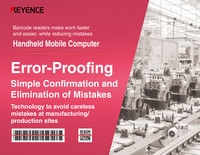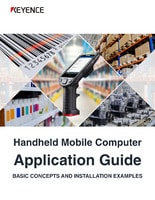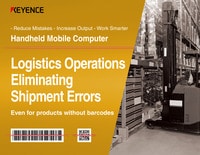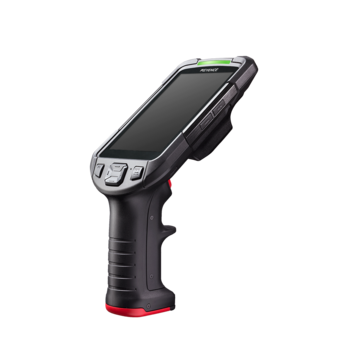Mobile Computers / Handheld Computers
- Handheld Computer in Automobiles / Transport Equipment Insudtry
- Handheld Computer in Electrical / Electronic Devices and Semiconductors Insudtry
- Handheld Computer in Food / Medicine / Cosmetics Insudtry
- Handheld Computer in Logistics Industry
- Handheld Computer in Specialized Stores Industry
- Handheld Computer in Volume Retailers Industry
Handheld Computer in Automobiles / Transport Equipment Insudtry
Typical handheld computer usage examples were explained in “Handheld Computer System Installation Applications,” but this section introduces actual application examples regarding automobiles / transport equipment in the manufacturing industry. Actual examples will be used to explain the problems in various processes at manufacturing sites for automobiles / transport equipment and the advantages provided by installing handheld computers in said sites.

Manufacturing of Automobiles / Transport Equipment
High quality and accuracy are required in the manufacturing of automobiles / transport equipment: a minor defect may lead to a major accident. For example, including small bolts, it is said that an automobile is made of over 30 thousand parts, and this count continues to grow as automobiles become more and more multifunctional. It is extremely difficult to inspect these parts perfectly and manage their information.
Furthermore, if an automobile / transport equipment recall occurs, it is necessary to immediately identify and collect all the affected products. In recent years, End-of-life Vehicle Recycling Law has also been enacted, which has led to requirements for traceability not only at manufacturers of completed vehicles but also at part manufacturers and car dealerships. To meet all these needs, there are limits to what people can physically do. Hence, in addition to the automation of manufacturing processes, the automation of information management with a handheld computer system installed is key.
Problems in Manufacturing of Automobiles / Transport Equipment
Production schedule delays directly affect delivery dates in manufacturing industries. This is not a problem that is limited just to the manufacturing of automobiles / transport equipment. The main cause is careless management of processes and inventory. While it is obvious that careless process management will lead to delays, careless inventory management such as mistakes in inspection and shelving during reception of materials will cause picking errors and thereby affect the manufacturing process schedule. If there are problems in inventory management, it will not be possible to accurately manage the manufacturing process, which will inevitably lead to an increase in waste in postprocessing.
Solving Problems by Installing Handheld Computers
If handheld computers are used to perform management with barcodes / 2D codes right from reception, the manufacturing process situation and the process work history data can be collected and made into a database immediately, which makes it possible to determine in real time what products are in what processes and are in what sort of semi-finished state. Who is performing what work and how long they are taking to do so can all be managed in a centralized manner, which improves efficiency by enabling accurate estimates of delivery dates and flexible assignment of personnel.
Typical Processes and Manufacturing Flow
This section explains detailed handheld computer installation examples grouped by process during the manufacturing of automobiles / transport equipment. The typical processes and manufacturing flow for automobiles / transport equipment are shown below.

Advantages Provided by Installing Handheld Computers in Various Processes
This section explains the advantages of installing handheld computers and actual application examples for the typical processes listed above.

Parts Receiving
Installing handheld computers makes it possible to read barcodes and similar items provided with parts and immediately convert the receiving information into data, which prevents careless mistakes caused by visual inspections. When parts are used on a manufacturing line, inventory is moved automatically, which eliminates the recording and data entry performed by personnel, thereby enabling correct inventory management. This greatly improves the accuracy of the inspection of receiving goods/incoming inspections.

Parts Warehousing
If mistakes occur in visual inspections during warehousing, confusion will arise during the picking of the parts required for the manufacturing line, and the subsequent processes will be greatly delayed. Also, the dispensing process, in which parts are lined up in the order in which work is performed, will also be thrown off. By using handheld computers and barcodes to associate product information with shelf information, this work can be made faster and more accurate. This enables accurate picking work, efficient inventory management, and major improvements in the speed of verification work.

Processing
Handheld computers can be used to perform overall operation management, work-hour management, insertion checks, and tool management in real time, which makes it easy to manage the progress of processes. In turn, this can be expected to lead to improved product quality. In addition to information on parts and products, the usage situation and consumption situation of consumables, equipment, and tools can also be determined, which is effective in the preventative maintenance in equipment management.
Assembly
Assembly mistakes are the typical problem that can happen easily in this process. Handheld computers can be used to check parts and to show the work procedure on the display just by scanning the codes on products and parts, thereby creating an assembly environment that anyone can understand easily. It is easy to mistake parts and products that have similar product numbers and shapes, but assembly mistakes can be reduced by performing management with items such as barcodes. In addition, the work record can be obtained automatically, which is effective for traceability.




Inspection
One of the advantages of installing handheld computers is that integration with the system makes it possible to simplify the registration of product serial numbers. Product traceability is also dramatically improved, so it is possible to immediately identify the process that was the cause of problems such as defective workpieces. Inspection results and repair results are converted to data on the spot, which makes it clear how to work toward quality improvements.

Finished Product Warehouse
Finished products are brought into the company's warehouse where they wait for delivery. Erroneous shipments can be greatly reduced by performing shipping inspections that do not rely on visual checks. Also, handheld computers can be integrated with the system to improve the efficiency of inventory management and inventory counting.
Related Downloads

How to implement Handheld Mobile Computers to error-proof processes and inspections.

This guide summarizes the applications of handheld mobile computers. It provides easy-to-understand descriptions, from basic knowledge such as the abilities of handheld mobile computers, the environment required for installation, and successful applications, to installation examples by industry and important points on selecting handheld mobile computers.

This document summarizes solutions to eliminate shipping mistakes in the logistics industry. It describes ways to use handheld mobile computers to prevent mistakes when packages have no barcodes and to solve problems in various processes such as receiving, shelving, picking, and shipping inspection.

This document covers the system of logistics and basic knowledge of operations, the roles required of next-generation logistics, methods to improve efficiency, and operation improvement examples. It is packed with useful information and recommended to everyone involved in logistics from beginners to experts.
Related Products
Industries
- Handheld Computer in Automobiles / Transport Equipment Insudtry
- Handheld Computer in Electrical / Electronic Devices and Semiconductors Insudtry
- Handheld Computer in Food / Medicine / Cosmetics Insudtry
- Handheld Computer in Logistics Industry
- Handheld Computer in Specialized Stores Industry
- Handheld Computer in Volume Retailers Industry

